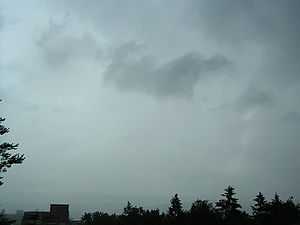Nimbostratus cloud
| Nimbostratus cloud | |
|---|---|
|
Nimbostratus with fractus | |
| Abbreviation | Ns |
| Symbol |
|
| Genus | Nimbostratus (rain, layered) |
| Species | none |
| Variety | none |
| Altitude |
below 3,000 m (below 10,000 ft) |
| Classification | Family D (Vertically developed) |
| Appearance | Dark, widespread, formless layer |
| Precipitation cloud? | Yes, but may be virga |
Nimbostratus is a low-to-middle étage stratiform cloud that has considerable vertical and horizontal extent and produces precipitation over a wide area. "Nimbo" is from the Latin word "nimbus", which denotes precipitation. It has a diffuse cloud base generally found anywhere from near surface and about 3,000 m (9,800 ft). This cloud typically forms from altostratus in the middle altitude range, but it tends to thicken into the low altitude range during precipitation. Although usually dark at its base, it often appears illuminated from within to a surface observer.[1] Nimbostratus usually has a thickness of about 2000 m. Though found worldwide, nimbostratus occurs more commonly in the middle latitudes.[2] It is coded CM2 on the SYNOP report.
- Species and varieties: Nimbostratus is very thick, opaque, and featureless, so this genus type is not subdivided into species or varieties.[3][4]
- Precipitation-based supplementary features: Nimbostratus is a major precipition cloud and produces the virga or praecipitatio features. The latter can achieve heavy intensity due to the cloud's vertical depth.
- Accessory cloud: Pannus frequently forms in precipitation and is coded CL7.
- Genitus mother clouds: This genus type can form from cumulus and cumulonimbus.
- Mutatus mother clouds: Nimbostratus can form due to the complete transformation of altocumulus, altostratus and stratocumulus.
Formation
Nimbostratus occurs along a warm front or occluded front where the slowly rising warm air mass creates nimbostratus along with shallower stratus clouds producing less rain, these clouds being preceded by higher-level clouds such as cirrostratus and altostratus.[5][6] Often, when an altostratus cloud thickens and descends into lower altitudes, it will become nimbostratus.[7]
Nimbostratus, unlike cumulonimbus, is not associated with thunderstorms, however at an unusually unstable warm front caused as a result of the advancing warm air being hot, humid and unstable, cumulonimbus clouds may be embedded within the usual nimbostratus. Lightning from an embedded cumulonimbus cloud may interact with the nimbostratus but only in the immediate area around it. In this situation with lightning and rain occurring it would be hard to tell which type of cloud was producing the rain from the ground, however cumulonimbus tend to produce larger droplets and more intense downpours. The occurrence of cumulonimbus and nimbostratus together is uncommon, and usually only nimbostratus is found at a warm front.
Nimbostratus pannus is an accessory cloud of nimbostratus that forms as a ragged layer in precipitation below the main cloud deck.[8]
Forecast

Usually, nimbostratus is a sign of steady moderate to heavy precipitation, as opposed to the shorter period of typically heavier precipitation released by a cumulonimbus cloud.[2] However, precipitation does not occur at ground level in case of virga and accompanies other cloud types. Precipitation may last for several days, depending on the speed of the warm or occluded front it accompanies.[5] A nimbostratus virga cloud is the same as a normal nimbostratus cloud, but the precipitation is virga and it never reaches the ground. Stratus or stratocumulus (comprising the warm sector of a frontal system) usually forms when it clears.
References
- ↑ World Meteorological Organization, ed. (1975). Nimbostratus, International Cloud Atlas (PDF) I. pp. 37–39. ISBN 92-63-10407-7. Retrieved 26 August 2014.
- ↑ 2.0 2.1 Pretor-Pinney, Gavin (2007). The Cloudspotter's Guide: The Science, History, and Culture of Clouds. Perigee. ISBN 0-399-53345-1.
- ↑ World Meteorological Organization, ed. (1975). Species, International Cloud Atlas (PDF). pp. 18–20. Retrieved 26 August 2014.
- ↑ World Meteorological Organization, ed. (1975). Varieties, International Cloud Atlas (PDF). pp. 20–22. Retrieved 26 August 2014.
- ↑ 5.0 5.1 Dunlop, Storm (2003). Weather Identification Handbook: The Ultimate Guide for Weather Watchers. Guilford, Connecticut: Globe Pequot. ISBN 1-58574-857-9.
- ↑ Thompson, Graham; Turk, Jonathan (1993). Earth Science and the Environment. Fort Worth: Saunders College Publishing. ISBN 0-03-075446-1.
- ↑ Lankford, Terry (2000). Aviation Weather Handbook. McGraw-Hill Professional. ISBN 978-0-07-136103-3.
- ↑ World Meteorological Organization, ed. (1975). Features, International Cloud Atlas (PDF) I. pp. 22–24. ISBN 92-63-10407-7. Retrieved 26 August 2014.
External links
| Wikimedia Commons has media related to Nimbostratus clouds. |
| ||||||||||||||||||||||||||||||||||||||
